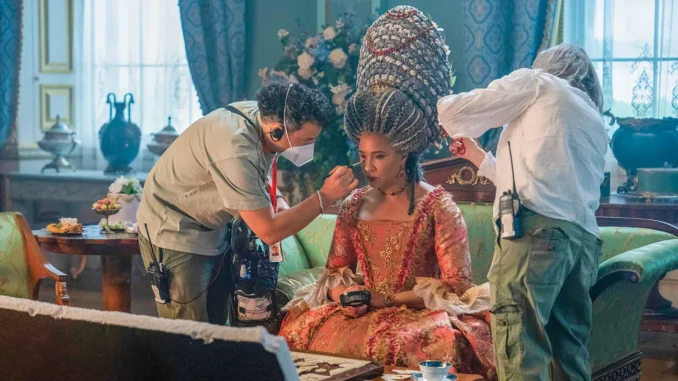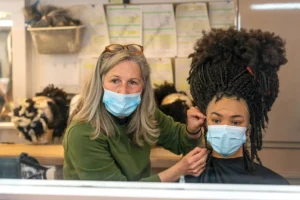
The Netflix dramas feature detailed interpretations of their monarchs’ coifs, but while one sometimes has to re-create a look exactly as it appeared on camera, the other has full creative license.
Throughout the respective seasons of The Crown and Queen Charlotte: A Bridgerton Story, the audience watches two royal women, Princess Diana and Charlotte, take charge of their narrative. Their evolution is also visible in their hair.
Diana’s hair grows out from her iconic crop in the fifth season of the Netflix drama, eventually getting sleeker and more glamorous as she liberates herself from her marriage to Prince Charles. “For me, that evolution is of someone who is taking her independence and realizing her own value, her star value and what she was doing,” says The Crown hair designer Cate Hall. “She sort of looked like a movie star by the end of that period.” It coincides with a change in hairdressing: “Her hair was silkier. Everything looked more glossy.”
Meanwhile, elsewhere on Netflix, the young Charlotte goes from confused newcomer in the court of George III to a powerful figure, embracing the towering updos she will wear in the future. “The one thing I really wanted to do was to make it really personal, like an intimate hair journey,” explains Queen Charlotte‘s hair designer Nic Collins, a two-time Emmy winner for Downton Abbey. “The way we achieved that was basing young Queen Charlotte’s ball wigs off of what we had done with the Regency Queen Charlotte.”

Both series are nominated for Emmys in outstanding period and/or character hairstyling. On the surface, they seem quite different despite their interest in the monarchy. Queen Charlotte spins off from Shonda Rhimes’ Bridgerton with a multiracial cast and an instrumental pop score that signals historical accuracy is not the primary target. The Crown is a detailed telling of Queen Elizabeth II’s reign that often gets as close to the factual record as possible. And yet Collins and Hall have similar approaches to how hair should function.
Both designers started from archival material and then, largely, put that away — a fact that is more surprising in the case of The Crown. “You’re using the reference, you’re faithful to it … and you hope to get to the point where you start to discard it, because there’s a kind of character evolving, which is this bastard love child between your character and your actor ,” Hall says. Of course, in the case of The Crown, there are some moments where you have to get it exactly right because the audience likely remembers it perfectly: for instance, when Elizabeth Debicki as Diana appears in her infamous “revenge dress” or during her infamous Panorama interview with Martin Bashir.
Hall does have to think about how she can turn an actor — who might look nothing like the real person — into a public figure audiences know well. When Hall learned Olivia Williams was cast as Camilla Parker Bowles this season, she thought there was “no way” she could transform her, given how different they look. “The key is always the wig fitting,” she says. “If you can tell someone’s brain — by giving them a hairline that’s really recognizable, that ‘this is this person’ — I feel like they fill in the gaps for you.”
Collins, in the case of Queen Charlotte, worked in the opposite direction, styling the character’s hair with actress India Amarteifio in mind. “As soon as I saw India and her beautiful mane of hair, it was always that I would push to use her own hair,” she said. Collins then built wigs that were modeled on Amarteifio’s actual hair texture. (She didn’t style Armateifio’s real hair, however, for fear of damaging it.) “From there, it was finding the shape that suited her, but trying to keep to the 18th century oval shape,” Collins says.
Collins was also styled for another Queen Charlotte — the older version of the character audiences know from Bridgerton played by Golda Rosheuvel, who exists in the Regency period and frequently wears towering wigs. The challenge was to find a way to innovate, Collins says. “I know the shape, I know how to build the cages, I know what the elements are, but I was trying to find something outside of that,” she adds. “I kept looking at images and I kept looking at reference pictures from hairstyles worldwide — all periods, all eras — and texture kept coming back to me.” The first one she built for Rosheuvel, she says, was a “totally contemporized period fusion.”
When it comes to the queen in The Crown, however, things remain a lot more static even if the actress changes between seasons. Imelda Staunton took over Elizabeth this year from Emmy winner Olivia Colman, but that coiffure? That remains mostly the same. As Hall says: “Can you imagine the queen without queenie hair?”
